Women's suffrage in the United Kingdom
| Part of a series on |
| Feminism |
|---|
 |
|
|
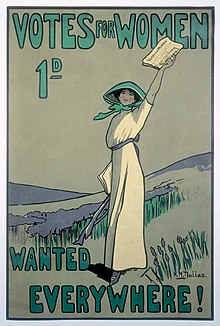
A movement to fight for
The outbreak of the First World War in 1914 led to a suspension of party politics, including the militant suffragette campaigns. Lobbying did take place quietly. In 1918 a coalition government passed the Representation of the People Act 1918, enfranchising all men over 21, as well as all women over the age of 30 who met minimum property qualifications. This act was the first to include almost all adult men in the political system and began the inclusion of women, extending the franchise by 5.6 million men[2] and 8.4 million women.[3] In 1928 the Conservative government passed the Representation of the People (Equal Franchise) Act 1928 equalizing the franchise to all persons, male and female, over the age of 21.
Background
Until the 1832
Both before and after the 1832 Reform Act there were some who advocated that women should have the right to vote in parliamentary elections. After the enactment of the Reform Act, the MP Henry Hunt argued that any woman who was single, a taxpayer and had sufficient property should be allowed to vote. One such wealthy woman, Mary Smith, was used in this speech as an example.
The
There is a poll book from 1843 that clearly shows thirty women's names among those who voted. These women were playing an active role in the election. On the roll, the wealthiest female elector was Grace Brown, a butcher. Due to the high rates that she paid, Grace Brown was entitled to four votes.[11]
Lilly Maxwell cast a high-profile vote in Britain in 1867 after the Great Reform Act of 1832.[12] Maxwell, a shop owner, met the property qualifications that otherwise would have made her eligible to vote had she been male. In error, her name had been added to the election register and on that basis she succeeded in voting in a by-election – her vote was later declared illegal by the Court of Common Pleas. The case gave women's suffrage campaigners great publicity.
Outside pressure for women's suffrage was at this time diluted by feminist issues in general. Women's rights were becoming increasingly prominent in the 1850s as some women in higher social spheres refused to obey the gender roles dictated to them. Feminist goals at this time included the right to sue an ex-husband after divorce (achieved in 1857) and the right for married women to own property (fully achieved in 1882 after some concession by the government in 1870).
The issue of parliamentary reform declined along with the Chartists after 1848 and only reemerged with the election of John Stuart Mill in 1865. He stood for office showing direct support for female suffrage and was an MP in the run up to the second Reform Act.
Early suffragist societies
In the same year that John Stuart Mill was elected (1865), the first ladies' discussion society, Kensington Society, was formed, debating whether women should be involved in public affairs.[13] Although a society for suffrage was proposed, this was turned down on the grounds that it might be taken over by extremists.
Later that year
The Manchester Society for Women's Suffrage was founded in February 1867. Its secretary, Lydia Becker, wrote letters both to Prime Minister Benjamin Disraeli and to The Spectator. She was also involved with the London group, and organised the collection of more signatures. Lydia Becker reluctantly agreed to exclude married women from the "Married Women's Property Act" reform demand.[15]
In June the London group split, partly a result of party allegiance, and partly the result of tactical issues. Conservative members wished to move slowly to avoid alarming public opinion, while Liberals generally opposed this apparent dilution of political conviction. As a result, Helen Taylor founded the London National Society for Women's Suffrage, which set up strong links with Manchester and Edinburgh. In Scotland one of the earliest societies was the Edinburgh National Society for Women's Suffrage.[16]
Although these early splits left the movement divided and sometimes leaderless, it allowed Lydia Becker to have a stronger influence. The suffragists were known as the parliamentarians.
In Ireland, Isabella Tod, an anti-Home Rule Liberal and campaigner for girls education, established the North of Ireland Women's Suffrage Society in 1873 (from 1909, still based in Belfast, the Irish WSS). Determined lobbying by the WSS ensured the 1887 Act creating a new municipal franchise for Belfast (a city in which women predominated due to heavy employment in mills) conferred the vote on "persons" rather than men. This was eleven years before women elsewhere Ireland gained the vote in local government elections.[17] The Dublin Women's Suffrage Association was established in 1874. As well as campaigning for women's suffrage, it sought to advance women's position in local government. In 1898, it changed its name to the Irish Women's Suffrage and Local Government Association.
Early legislative efforts
In 1868, John Stuart Mill brought to Parliament a petition for female suffrage with 21,557 signatures. In 1870, Bright's introduced the Women's Disabilities Removal Bill[18] which would have extended the parliamentary franchise to women on the same terms as men. In May 1871, the bill was defeated in the Commons by a division of 220 to 151.[19] With varying degrees cross-party support, private member's bills caused the subject to be debated in the House of Commons again in 1872, 73, 75, 76, 77, 78, 79, 83, 84 (twice), 86, 92, 97, and 1904. From 1886 onwards, every vote taken had shown the majority of MPs in favour of women's suffrage, but without government support, and with opposition in the Lords, the bills were crowded out of the legislative agenda.[19]
In 1910, 1911, and 1912, there were three "Conciliation bills" which, suffrage equality, offered women a more restrictive property-qualified vote. The 1912 bill was defeated by 208 to 222.[20] The Women's Social and Political Union blamed Prime Minister Asquith, as the eight members of the Liberal Government whose votes against the measure sealed its fate.[21]
Formation of a national movement
Women's political groups
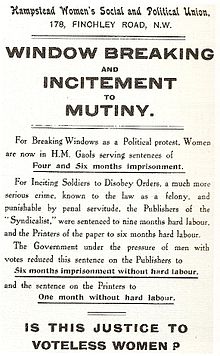
Although women's political party groups were not formed with the aim to achieve women's suffrage, they did have two key effects. Firstly, they showed women who were members to be competent in the political arena and as this became clear, secondly, it brought the concept of female suffrage closer to acceptance.
Primrose League
The Primrose League (1883–2004) was set up to promote Conservative values through social events and supporting the community. As women were able to join, this gave females of all classes the ability to mix with local and national political figures. Many also had important roles such as bringing voters to the polls. This removed segregation and promoted political literacy among women. The League did not promote women's suffrage as one of its objectives.[citation needed]
Women's Liberal Associations
Although there is evidence to suggest that they were originally formed to promote female franchise (the first being in Bristol in 1881), WLAs often did not hold such an agenda. They operated independently from the male groups, and did become more active when they came under the control of the Women's Liberal Federation, and canvassed all classes for support of women's suffrage and against domination.
There was significant support for woman suffrage in the Liberal Party, which was in power after 1905, but a handful of leaders, especially H. H. Asquith, blocked all efforts in Parliament.[22]
Pressure groups
The campaign first developed into a national movement in the 1870s. At this point, all campaigners were suffragists, not
In 1868, local groups amalgamated to form a series of close-knit groups with the founding of the National Society for Women's Suffrage (NSWS). This is notable as the first attempt to create a unified front to propose women's suffrage, but had little effect due to several splits, once again weakening the campaign.
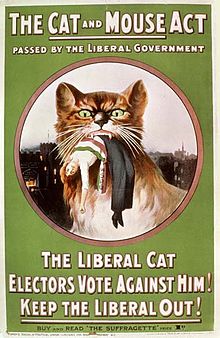
Up until 1897, the campaign stayed at this relatively ineffective level. Campaigners came predominantly from the landed classes and joined together on a small scale only. In 1897 the National Union of Women's Suffrage Societies (NUWSS) was founded by Millicent Fawcett. This society linked smaller groups together and also put pressure on non-supportive MPs using various peaceful methods.
Pankhursts and suffragettes
Founded in 1903, the
The
The tactics of the WSPU included shouting down speakers, hunger strikes, stone-throwing, window-smashing,
Historian
Smith concludes:[32]
Although non-historians often assumed the WSPU was primarily responsible for obtaining women's suffrage, historians are much more skeptical about its contribution. It is generally agreed that the WSPU revitalized the suffrage campaign initially, but that its escalation of militancy after 1912 impeded reform. Recent studies have shifted from claiming that the WSPU was responsible for women's suffrage to portraying it as an early form of radical feminism that sought to liberate women from a male-centered gender system.
First World War
The greater suffrage efforts halted with the outbreak of World War I. While some activity continued, with the NUWSS continuing to lobby peacefully, Emmeline Pankhurst, convinced that Germany posed a danger to all humanity, persuaded the WSPU to halt all militant suffrage activity.
Parliament expands suffrage 1918
During the war, a select group of parliamentary leaders decided on a policy that would expand the suffrage to all men over the age of 21, and propertied women over the age of 30. Asquith, an opponent, was replaced as prime minister in late 1916 by David Lloyd George who had, for his first ten years as an MP, argued against women having the franchise.
During the war there was a serious shortage of able-bodied men and women were able to take on many of the traditionally male roles. With the approval of the trade unions, "dilution" was agreed upon. Complicated factory jobs handled by skilled men were diluted or simplified so that they could be handled by less skilled men and women. The result was a large increase in women workers, concentrated in munitions industries of highest priority to winning the war. This led to a increased societal understanding of what work women were capable of. Some believe that the franchise was partially granted in 1918 because of a decline in anti-suffrage hostility caused by pre-war militant tactics. However, others believe that politicians had to cede at least some women the vote so as to avoid the promised re-resurgence of militant suffrage action. Many of the major women's groups strongly supported the war effort. The Women's Suffrage Federation, based in the east end and led by Sylvia Pankhurst, did not. The federation held a pacifist stance and created co-operative factories and food banks in the East End to support working class women throughout the war. Until this point suffrage was based on occupational qualifications of men. Millions of women were now meeting those occupational qualifications, which in any case were so old-fashioned that the consensus was to remove them. For example, a male voter who joined the Army might lose the right to vote. In early 1916, suffragist organizations privately agreed to downplay their differences, and resolve that any legislation increasing the number of votes should also enfranchise women. Local government officials proposed a simplification of the old system of franchise and registration, and the Labour cabinet member in the new coalition government, Arthur Henderson, called for universal suffrage, with an age cutoff of 21 for men and 25 for women. Most male political leaders showed anxiety about having a female majority in the new electorate. Parliament turned over the issue to a new Speakers Conference, a special committee from all parties from both houses, chaired by the Speaker. They began meeting in October 1916, in secret. A majority of 15 to 6 supported votes for some women; by 12 to 10, it agreed on a higher age cut off for women.[33] Women leaders accepted a cutoff age of 30 in order to get the vote for most women.[34]
Finally in 1918, Parliament passed an act granting the vote to women over the age of 30 who were householders, the wives of householders, occupiers of property with an annual rent of £5, and graduates of British universities. About 8.4 million women gained the vote.[35] In November 1918, the Parliament (Qualification of Women) Act 1918 was passed, allowing women to be elected into the House of Commons.[35] By 1928 the consensus was that votes for women had been successful. With the Conservative Party in full control in 1928, it passed the Representation of the People (Equal Franchise) Act that extended the voting franchise to all women aged 21, granting women the vote on the same terms as men,[36][37] although one Conservative opponent of the bill warned that it risked splitting the party for years to come.[38]
Women in prominent roles
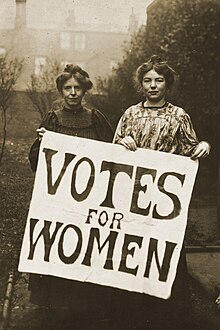
Another key figure was
Mary Gawthorpe was an early suffragette who left teaching to fight for women's voting rights. She was imprisoned after heckling Winston Churchill. She left England after her release, eventually emigrating to the United States and settling in New York. She worked in the trade union movement and in 1920 became a full-time official of the Amalgamated Clothing Workers Union. In 2003, Mary's nieces donated her papers to New York University.[46]
Male suffragists
Males were also present in the suffrage movement.
Laurence Housman
Laurence Housman was a male feminist who devoted himself to the suffrage movement. Most of his contributions were through creating art, such as propaganda, with the intent of helping women in the movement to better express themselves,[47] influencing people to join the movement[48] and informing people about particular suffrage events such as the 1911 Census protest.[49] He and his sister, Clemence Housman, created a studio called the Suffrage Atelier which aimed to create propaganda for the suffrage movement.[50] This was significant because he produced a space for women to create propaganda to better aid the suffrage movement and, at the same time, earn money by selling the art.[47] Also, he created propaganda such as the Anti-Suffrage Alphabet,[51] and wrote for many women's newspapers.[51] Additionally, he also influenced other men to aid the movement.[48] For example, he formed the Men’s League for Women’s Suffrage with Israel Zangwill, Henry Nevinson and Henry Brailsford, hoping to inspire other men to participate in the movement.[48]
Legacy
Whitfield concludes that the militant campaign had some positive effects in terms of attracting enormous publicity, and forcing the moderates to better organise themselves, while also stimulating the organization of the antis. He concludes:[52]
The overall effect of the suffragette militancy, however, was to set back the cause of women's suffrage. For women to gain the right to vote it was necessary to demonstrate that they had public opinion on their side, to build and consolidate a parliamentary majority in favour of women's suffrage and to persuade or pressure the government to introduce its own franchise reform. None of these objectives was achieved.
The Emmeline and Christabel Pankhurst Memorial in London was first dedicated to Emmeline Pankhurst in 1930, with a plaque added for Christabel Pankhurst in 1958.
To commemorate the 100th anniversary of Women being given the right to vote, a statue of Millicent Fawcett was erected in Parliament Square, London in 2018.[53] The photo colouriser Tom Marshall released a series of photos to mark the 100th anniversary of the vote, including an image of suffragettes Annie Kenney and Christabel Pankhurst, which appeared on The Daily Telegraph front page on 6 February 2018.[54]
Timeline
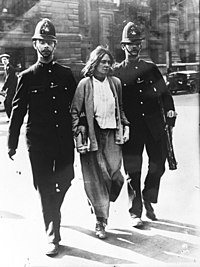
- 1818: Jeremy Bentham advocates female suffrage in his book A Plan for Parliamentary Reform. The Vestries Act 1818 allowed some single women to vote in parish vestry elections.[8]
- 1832: Great Reform Act – confirmed the exclusion of women from the electorate.
- 1851: The Sheffield Female Political Association is founded and submits a petition calling for women's suffrage to the House of Lords.
- 1864: The first Contagious Disease Act is passed in England, which is intended to control venereal disease by having prostitutes and women believed to be prostitutes locked away in hospitals for examination and treatment. When information broke to the general public about the shocking stories of brutality and vice in these hospitals, Josephine Butler launched a campaign to get it repealed. Many have since argued that Butler's campaign destroyed the conspiracy of silence around sexuality and forced women to act in protection of others of their sex. In doing so, clear linkages emerge between the suffrage movement and Butler's campaign.[55]
- 1865: John Stuart Mill elected as an MP showing direct support for women's suffrage.
- 1867: Second Reform Act – Male franchise extended to 2.5 million.
- 1869: Municipal Franchise Act gives single women
- 1883: Conservative Primrose League formed.
- 1884: Third Reform Act – Male electorate doubled to 5 million.
- 1889: Women's Franchise League established.
- 1894: Local Government Act (women could vote in local elections, become District Councillors [though not their Chairmen], Poor Law Guardians, act on School Boards)
- 1894: The publication of C.C. Stopes's British Freewomen, staple reading for the suffrage movement for decades.[56]
- 1897: National Union of Women's Suffrage Societies NUWSS formed (led by Millicent Fawcett).
- 1903: Women's Social and Political Union WSPU is formed (led by Emmeline Pankhurst)
- 1904: Militancy begins. Emmeline Pankhurst interrupts a Liberal Party meeting.[57]
- February 1907: Mud March" – largest open air demonstration ever held (at that point) – over 3000 women took part. In this year, women were admitted to the register to vote in and stand for election to principal local authorities.
- 1907: The Artists' Suffrage League founded
- 1907: The Women's Freedom League founded
- 1908: Actresses Franchise League founded
- 1908: Women Writers' Suffrage League founded
- 1908: in November of this year, Elizabeth Garrett Anderson, a member of the small municipal borough of Aldeburgh, Suffolk, was selected as mayor of that town, the first woman to so serve.
- 1907, 1912, 1914: major splits in the WSPU
- 1905, 1908, 1913: Three phases of WSPU militancy (Civil Disobedience; Destruction of Public Property; Arson/Bombings)
- 5 July 1909: Marion Wallace Dunlop went on the first hunger strike – was released after 91 hours of fasting
- 1909 The Women's Tax Resistance League founded
- September 1909: Force feeding introduced to hunger strikers in English prisons
- 1910: Lady Constance Lytton disguised herself as a working-class seamstress, Jane Wharton, and was arrested and endured force feeding that cut down her life span considerably[58]
- February 1910: Cross-Party Conciliation Committee (54 MPs). Conciliation Bill (that would enfranchise women) passed its 2nd reading by a majority of 109 but H. H. Asquithrefused to give it more parliamentary time
- November 1910: Asquith changed the Bill to enfranchise more men instead of women
- 18 November 1910: Black Friday[59]
- October 1912: George Lansbury, Labour MP, resigned his seat in support of women's suffrage
- February 1913: WSPU[60]despite his support for women's suffrage.
- April 1913: Cat and Mouse Act passed, allowing hunger-striking prisoners to be released when their health was threatened and then re-arrested when they had recovered. The first suffragist to be released under this act was Hugh Franklin and the second was his soon-to-be wife Elsie Duval
- 4 June 1913: Emily Davison walked in front of, and was subsequently trampled and killed by, the King’s Horse at The Derby.
- 13 March 1914: National Gallery with an axe, protesting that she was maiming a beautiful woman just as the government was maiming Emmeline Pankhurstwith force feeding
- 4 August 1914: World War declared in Britain. WSPU activity immediately ceased. NUWSSactivity continued peacefully – the Birmingham branch of the organisation continued to lobby Parliament and write letters to MPs.
- 1915–16: Border polls under Welsh Church Act 1914held under universal adult suffrage.
- 6 February 1918: The Representation of the People Act of 1918 enfranchised women over the age of 30 who were either a member or married to a member of the Local Government Register. About 8.4 million women gained the vote.[35][61]
- 21 November 1918: the Parliament (Qualification of Women) Act 1918 was passed, allowing women to be elected to Parliament.[35]
- 1928: Women in England, Wales and Scotland received the vote on the same terms as men (over the age of 21, without property requirements) as a result of the Representation of the People Act 1928.[62]
- 1968–1969: The Electoral Law Act (Northern Ireland) and the Representation of the People Act 1969 reduced the voting age to 18 for men and women alike
- 1973: The fully enfranchised Northern Irish local elections of May 1973 saw the first time all government elected officials across the UK were elected under universal suffrage.
See also
- Feminism in the United Kingdom
- Lobbying in the United Kingdom
- The Women's Library (London)
- List of suffragists and suffragettes
- List of women's rights activists
- Timeline of women's suffrage
- Women's suffrage activism in Leigh
- Women's suffrage in Scotland
- Suffragette bombing and arson campaign
- List of suffragette bombings
- Women in the House of Commons of the United Kingdom
- Anti-suffragism
- Suffrage jewellery
- Women's suffrage in the Cayman Islands
- Women's suffrage in India
References
- ^ See NUWSS.
- ISBN 978-1-317-86225-3.
- ISBN 978-0-19-913373-4.
- ISBN 9780748626724.
- ^ ISBN 9780748626724.
- ^ a b "Women's rights". The National Archives. Retrieved 11 February 2015.
- ^ a b "Which Act Gave Women the Right to Vote in Britain?". Synonym. Retrieved 11 February 2015.
- ^ a b "Female Suffrage before 1918", The History of the Parliamentary Franchise, House of Commons Library, 1 March 2013, pp. 37–9, retrieved 16 March 2016
- ^ a b The First Report of the Commissioners for Church Temporalities in Wales (1914–16) Cd 8166, p 5; Second Report of the Commissioners for Church Temporalities in Wales (1917–18) Cd 8472 viii 93, p 4.
- S2CID 144909754. Retrieved 5 June 2021.
- ^ Sarah Richardson (18 March 2013). "Women voted 75 years before they were legally allowed to in 1918". The Telegraph. Archived from the original on 12 January 2022. Retrieved 4 September 2016.
- ISBN 978-0-19-820775-7.
- doi:10.1093/ref:odnb/92488. (Subscription or UK public library membershiprequired.)
- ISBN 9781446413500.
- JSTOR 2168771.
- ^ "Edinburgh National Society for Women's Suffrage". 1876.
- ISBN 978-1-84631-635-7.
- ^ "Women's Disabilities Removal Bill | Encyclopedia.com". www.encyclopedia.com. Retrieved 13 April 2023.
- ^ a b Wojtczak, Helena (2009). "British Women's Emancipation since the Renaissance". www.hastingspress.co.uk. Retrieved 13 April 2023.
- ^ Hansard, HC 5ser vol 36 col 728-31
- ^ "The Conciliation Bill Rejection", The Times, 1 April 1912, p. 6.
- ISBN 9780199133734.
- ^ Jane Marcus, Suffrage and the Pankhursts (2013).
- ^ "The Struggle for Suffrage". historicengland.org.uk. Historic England. Retrieved 3 October 2017.
- ISBN 9780226802459.
- ^ History Ireland (24 January 2013). "Irish Suffragettes at the time of the Home Rule Crisis". Retrieved 8 March 2020.
- ISBN 9781909556065.
- ^ Toal, Ciaran (2014). "The brutes - Mrs Metge and the Lisburn Cathedral, bomb 1914". History Ireland. Retrieved 22 November 2019.
- ^ Pugh 2012, p. 152.
- ISBN 9780435327170.
- ISBN 9781317862253.
- ISBN 9781317862253.
- ^ Arthur Marwick, A History of the Modern British Isles, 1914–1999: Circumstances, Events and Outcomes (Wiley-Blackwell, 2000), pp. 43–45.
- ISBN 9781108026604.
- ^ a b c d Fawcett, Millicent Garrett. The Women's Victory – and After, Cambridge University Press, p. 170.
- ISBN 9780435327316.
- ^ D. E. Butler, The Electoral System in Britain 1918–1951 (1954), pp. 15–38.
- ^ Oman, Sir Charles (29 March 1928). "REPRESENTATION OF THE PEOPLE (EQUAL FRANCHISE) BILL. 2nd reading debate". Parliamentary Debates (Hansard).
- OCLC 28710360.
- ^ Marina Warner, "The Agitator: Emmeline Pankhurst", Time 100,Time Magazine.
- ^ "The Early Suffrage Societies in the 19th century – a timeline". UK Parliament. Retrieved 3 October 2017.
- ^ Jone Johnson Lewis, "Millicent Garrett Fawcett", ThoughtCo.com.
- ^ Jone Johnson Lewis, "Elizabeth Garrett Anderson", ThoughtCo.com.
- ^ Jone Johnson Lewis, "Emily Davies", ThoughtCo.com.
- ^ Jone Johnson Lewis, "Barbara Bodichon", ThoughtCo.com.
- ^ "Guide to the Mary E. Gawthorpe Papers TAM.275". dlib.nyu.edu. Retrieved 22 March 2018.
- ^ S2CID 144118253.
- ^ S2CID 241653187.
- S2CID 154796763.
- ^ Liddington, Jill (2014). Vanishing for the Vote : Suffrage, Citizenship and the Battle for the Census. Manchester, UK: Manchester University Press.
- ^ JSTOR j.ctt1g69xrh.58
- ISBN 9780435327170.
- ^ "First statue of a woman in Parliament Square unveiled". The Guardian. 3 April 2017.
- ^ McCann, Kate (6 February 2018). "Suffragettes 'should be pardoned'". The Daily Telegraph. Retrieved 20 August 2020.
- ^ Kent 2014, p. 7.
- ^ Mayall 2000, p. 350.
- ^ "Timeline", Britain 1906 – 1918.
- ^ Purvis 1995, p. 120.
- ^ BBC Radio 4 – Woman's Hour – Women's History Timeline: 1910 – 1919
- ISBN 9780026055901.
- ^ Butler, The Electoral System in Britain 1918–1951 (1954), pp. 7–12.
- ^ Butler, The Electoral System in Britain 1918–1951 (1954), pp. 15–38.
Further reading
- Arnstein, Walter L. "Votes For Women: Myths and Reality." History Today (Aug 1968), Vol. 18 Issue 8, pp 531–539; online; covers 1860 to 1918.
- Cairnes, John Elliot (1874). . Manchester: Alexander Ireland & Co.
- Crawford, Elizabeth (1999). The Women's Suffrage Movement: A Reference Guide 1866–1928. London: UCL Press.
- Crossley, Nick; et al. (2012). "Covert social movement networks and the secrecy-efficiency trade off: The case of the UK suffragettes (1906–1914)" (PDF). Social Networks. 34 (4): 634–644. .
- Crawford, Elizabeth (2013). The Women's Suffrage Movement in Britain and Ireland: A Regional Survey. Routledge.
- Fletcher, Ian Christopher, et al eds. Women's Suffrage in the British Empire: Citizenship, Nation and Race (2000),
- Greenwood Harrison, Patricia (2000). Collecting Links: The British and American Woman Suffrage Movements, 1900–1914. Westport, CT: Greenwood Press.
- Griffin, Ben (2012). The Politics of Gender in Victorian Britain: Masculinity, Political Culture and the Struggle for Women's Rights. Cambridge University Press.
- Jenkins, Lyndsey. Lady Constance Lytton: Aristocrat, Suffragette, Martyr (Biteback Publishing, 2015).
- Judge, Tony. Margaret Bondfield: First Woman in the Cabinet (Alpha House, 2018)
- Kent, Susan Kingsley (2014) [1987]. Sex and Suffrage in Britain, 1860–1914. Princeton Legacy Library. Princeton, NJ: Princeton University Press.
- Mayall, Laura E. Nym (2000). "Defining Militancy: Radical Protest, the Constitutional Idiom, and Women's Suffrage in Britain, 1908–1909". The Journal of British Studies. 39 (3): 340–371. S2CID 145258565.

- Mayhall, Laura E. Nym. The Militant Suffrage Movement: Citizenship and Resistance in Britain, 1860–1930 (Oxford UP, 2003) online
- Pugh, Martin (2012). State and Society: A Social and Political History of Britain Since 1870 (4th ed.). London and New York: Bloomsbury Academic. ISBN 978-1-780-93041-1.
- Pugh, Martin. The March of the Women: A Revisionist Analysis of the Campaign for Women's Suffrage, 1866-1914 (Oxford UP, 2000) online
- Purvis, June; Sandra, Stanley Holton, eds. (2000). Votes For Women. London: Routledge.; 12 essays by scholars
- Smith, Harold L. (2010). The British Women's Suffrage Campaign, 1866–1928 (Revised 2nd ed.). Abingdon: Routledge. ISBN 978-1-408-22823-4.
- Smith, Goldwin (1875). . London: MacMillan and Co.
- Wallace, Ryland (2009). The Women's Suffrage Movement in Wales, 1866–1928. Cardiff: ISBN 978-0-708-32173-7.
- Whitfield, Bob (2001). The Extension of the Franchise, 1832–1931. Oxford: Heinemann. ISBN 978-0-435-32717-0.
- Wingerden, Sophia A. van (1999). The Women's Suffrage Movement in Britain, 1866–1928. Basingstoke: Palgrave Macmillan. ISBN 978-0-333-66911-2.
Historiography and memory
- Clark, Anna. "Changing Concepts of Citizenship: Gender, Empire, and Class," Journal of British Studies 42.2 (2003): 263-270.
- DeVries, Jacqueline R. "Popular and smart: Why scholarship on the women’s suffrage movement in Britain still matters." History Compass 11.3 (2013): 177-188. online
- DiCenzo, Maria. "Justifying Their Modern Sisters: History Writing and the British Suffrage Movement." Victorian Review 31.1 (2005): 40-61. online
- Gavron, Sarah (2015). "The making of the feature film Suffragette". Women's History Review. 24 (6): 985–995. S2CID 146584171.
- Nelson, Carolyn Christensen, ed. (2004). Literature of the Women's Suffrage Campaign in England. Broadview Press.
- Purvis, June, and June Hannam. "The women’s suffrage movement in Britain and Ireland: new perspectives." Women's History Review (Nov 2020) 29#6 pp 911–915
- Purvis, June (2013). "Gendering the Historiography of the Suffragette Movement in Edwardian Britain: some reflections". Women's History Review. 22 (4): 576–590. S2CID 56213431.

- Seabourne, Gwen (2016). "Deeds, Words and Drama: A Review of the Film Suffragette". Feminist Legal Studies. 24 (1): 115–119. .
- Smitley, Megan. "'inebriates', 'heathens', templars and suffragists: Scotland and imperial feminism c. 1870-1914." Women's History Review 11.3 (2002): 455-480. online
Primary sources
- Lewis, J., ed. Before the Vote Was Won: Arguments for and Against Women's Suffrage (1987)
- McPhee, C., and A. Fitzgerald, eds. The Non--Violent Militant: Selected Writings of Teresa Billington-Greig (1987)
- Marcus, J., ed. Suffrage and the Pankhursts (1987)
External links
- The struggle for democracy – information on the suffragettes at the British Library learning website
- https://www.sheffield.gov.uk/libraries/archives-and-local-studies/research-guides/womens-suffrage.html Sources for the Study of Women's Suffrage in Sheffield, UK produced by Sheffield City Council's Libraries and Archives.
- Gladstone, William Ewart (1892).. London: John Murray.
- William Murphy: Suffragettes, in: 1914-1918-online. International Encyclopedia of the First World War.
- Nicoletta F. Gullace: Citizenship (Great Britain), in: 1914-1918-online. International Encyclopedia of the First World War.

